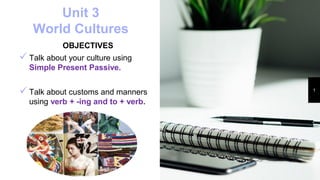
Intermediate II Unit 3 World Cultures
- 1. Unit 3 World Cultures OBJECTIVES Talk about your culture using Simple Present Passive. Talk about customs and manners using verb + -ing and to + verb. 1
- 2. Let’s talk! Ecuadorian culture What are some of the cultural traditions in your country? Think of a typical…
- 3. What is fanesca made of? What handicrafts are exported and sold all over the world? What traditional festivals are held in Ecuador? What is it called the instrument some ecuadorians play?
- 4. GRAMMAR POINT Active or Passive Voice? Brainstorming
- 5. ➔Active voice = focuses on the “doer”. Subject + Verb + Object Examples - IBM sells computers. - Pablo broke his umbrella. - The worker will close the store.
- 6. ➔Passive voice = focuses on the “receiver”. We are more interested in the object. ➔Because of this, we say the object first. STRUCTURE: Object/receiver + am/is/are + past participle + (by Subject)
- 7. Example: Bryan sells computers. (Active) Computers are sold (by Bryan). (Passive) Past Participle * In passive sentences, you can add the subject with the preposition "by" if you think it is important,
- 8. TEAM WORK 1 Change the following questions into PASSIVE VOICE! 8 1. When do people sing the national anthem? When is the national anthem sung? 2. How do you make your favorite traditional food? Do you serve it cold? How is your favorite traditional food made? Is it served cold? 3. Do both men and women play your country’s national sports? Are your country’s national sports played by both men and women? 4. When do people celebrate your most important festivals? When are your country’s national sports played by both men and women?
- 9. 9 5. When do people wear the national costume? Do people wear it a lot? When is the national costume worn ? Is it worn a lot? 6. Do people play traditional folk music? Is traditional folk music played? 7. Do people make traditional handicrafts? Where do they sell them? Are traditional handicrafts made? Where are they sold?
- 10. CLASSWORK Part A (15’) 1. Page 22 Exercise C 2. Once done, compare your answers with a partner. 3. P1 Classwork 3 Unit 3 Passive voice 4. Password: Ppassive
- 11. Manners What behaviors are considered acceptable in your country? It’s acceptable to… It’s NOT acceptable to…
- 12. TEAM WORK 2 What about these behaviors? Are they considered acceptable around the world?
- 18. Let’s check!
- 19. GRAMMAR POINT Verb +-ing and to + verb Position of not
- 20. VERB + ING AS A SUBJECT • EATING IN PUBLIC IS BAD MANNERS. subject • NOT SHAKING HANDS IS IMPOLITE. subject
- 21. VERB + ING AFTER PREPOSITIONS • YOU CAN OFFEND PEOPLE BY EATING IN PUBLIC. PREPOSITION
- 22. VERB + ING AFTER PREPOSITIONS • PEOPLE MIGHT STARE AT YOU FOR NOT SHAKING HANDS. PREPOSITION
- 23. TO + VERB AFTER IT´S • IT´S BAD MANNERS TO EAT IN PUBLIC.
- 24. POSITION OF NOT • NOT comes before the word it negates. • Be careful NOT to point at people.
- 25. POSITION OF NOT • It´s acceptable not to tip cab drivers. S Adj. (It´s optional) • It´s not acceptable to tip cab drivers. (You shouldn´t do it)
- 26. CLASSWORK Part B (15’) 1. Pages 24-25-30 2. Once done, compare your answers with a partner. 3. P1 Quiz 3 Unit 3 Lessons A-B 4. P1 Assignment 3 Unit 3 Summary, 23:59pm.
- 27. THANKS! Today we learned… Talk about your culture using Simple Present Passive. Talk about customs and manners using verb + - ing and to + verb. 27
- 28. Oral Presentation 3 students in each group 5 minutes per group (maximum) Content: -Use and structure -Examples (own) -Exercises/Game Explaining is better than reading. Grading rubric!